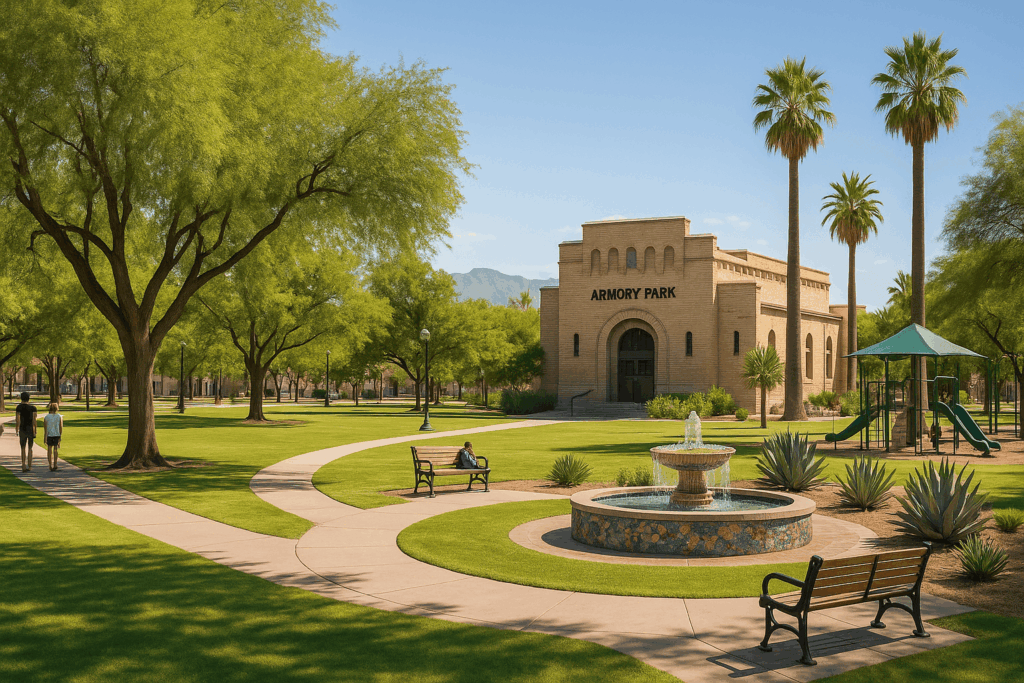Head to Tucson’s Armory Park neighborhood for a deep dive into the city’s railroad-era heritage. Established in the 1880s, Armory Park grew up around Tucson’s first train station and quickly became home to business owners, civic leaders and artisans. Today, this walkable district features an array of Victorian, Craftsman and Prairie School–style buildings set among mature shade trees. The Armory Park Tour offers a detailed look at these historic landmarks and the people who shaped Tucson’s early growth.
Tour Overview
This two-hour, small-group walking tour is led by longtime Tucson historian Alan Kruse. Beginning at 10:00 AM, the tour covers the western half of Armory Park, moving at a leisurely pace with frequent stops for storytelling and photo opportunities. Participants receive a printed neighborhood map and a timeline of key events in Tucson history. Tours are capped at 15 people to ensure an intimate, interactive experience.
Architectural Styles
Armory Park’s built environment reflects the evolving tastes of late 19th and early 20th century Tucson:
- Queen Anne Victorians: Characterized by steeply pitched roofs, decorative trim and wrap-around porches. These homes showcased the prosperity of early merchants and civic leaders.
- Craftsman Bungalows: Emphasizing hand-crafted woodwork, low-slung rooflines and deep overhangs. Built during the neighborhood’s boom in the 1910s and 1920s.
- Prairie School: Featuring horizontal lines, broad eaves and ribbon windows influenced by Frank Lloyd Wright’s designs. Rare examples in Tucson highlight local adaptation of this Midwestern style.
- Moorish and Mission Revival: Public buildings like the Scottish Rite Cathedral blend Spanish and North African motifs, reflecting Tucson’s cultural connections.
Historical Highlights
- Blenman Inn (1905): Once a private residence, this Queen Anne landmark hosted Tucson’s social elite. Today it operates as a bed-and-breakfast and event venue.
- Carnegie Free Library (1901): Funded by Andrew Carnegie, this small masonry building was Tucson’s first public library and remains a vibrant community space.
- Scottish Rite Cathedral (1928): Noted for its Moorish arches, polychrome tile and stained glass, the cathedral hosts cultural events and Masonic ceremonies.
- Hohokam Canal Remains: Visible irrigation channels from the prehistoric Hohokam civilization run beneath sidewalk grates, linking modern Tucson with its ancient agricultural roots.
Community Impact and Preservation
Armory Park exemplifies successful historic preservation in Tucson. In the 1970s, local advocates formed the Armory Park Historical Society to save threatened buildings from demolition. Their efforts secured National Register of Historic Places status for much of the district. Today, ongoing restoration projects and design guidelines maintain the neighborhood’s architectural integrity while allowing for modern living. Tour proceeds support the society’s educational programs and building-rehabilitation grants.
Tour Details
Date: March 8, 2025
Time: 10:00 AM to 12:00 PM
Meeting Point: Across from the Blenman Inn, 204 S. Scott Avenue, Tucson, AZ 85701
Cost: $20 for members, $35 for non-members
Capacity: Maximum 15 participants per tour
Registration: Reserve your spot at tucsonpresidio.com
Accessibility and Visitor Tips
- Wear comfortable shoes: Tour includes mostly paved streets but some uneven sidewalks.
- Sun protection: Bring a hat and water bottle, especially in early spring when temperatures can rise quickly.
- Photography: Early morning light is ideal for capturing building details and shaded tree canopies.
- Restroom stops: Public restrooms are available at the Armory Park Visitors Center before the tour start.
- Parking: Free on-street parking is plentiful along Scott Avenue and adjacent side streets.
Additional Resources
For more on Tucson history and preservation:

